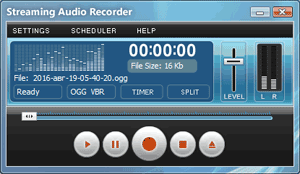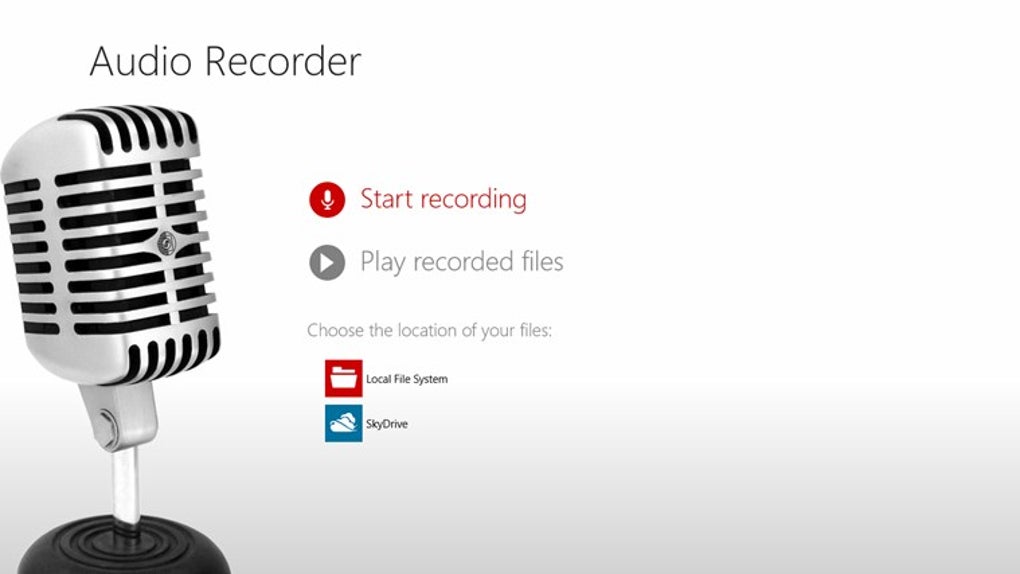Simple Audio Recorder for Windows 10 This is a simple audio recorder, that saves your audio records in m4a-files and play this files. Nov 15, 2013 Download this app from Microsoft Store for Windows 10, Windows 10 Mobile, Windows 10 Team (Surface Hub), HoloLens. See screenshots, read the latest customer reviews, and compare ratings for Windows Voice Recorder.
- You don’t have to hold up a microphone to your computer’s speakers to record its audio. Even if you don’t have a Stereo Mix option on your PC, you can easily record the sound coming from any Windows PC. You can record the sound coming from your PC in numerous ways, and we’re going to show you the three best we’ve found.
- Easy Guide: How to Record Audio on Windows 10 1. Go to the music sites (Vevo, Pandora, etc.) or open the applications (iTunes, Spotify, Skype, etc.) that you want to record the audio from. Click the 'Record' button for recording. Play the audio, and then record the audio from the website.
Although you can use many apps to record audio on your device, Windows 10 includes a free Voice Recorder app, and you can use it to record interviews, conversations, lectures, and well, pretty much anything that makes a sound.
The app is very simple, and it includes all the necessary features to record, trim, flag important moments, and share audio effortlessly.
In this Windows 10 guide, we walk you through the steps to get started using the Voice Recorder app on your device.
How to install Voice Recorder app on Windows 10

Voice Recorder comes with every installation of Windows 10, but if it's not available on your device, you can install it with these steps:
- Open Microsoft Store.
- Search for Windows Voice Recorder, and click the top result.
Click the Get button.
Once you complete these steps, you can start using the app to record audio on your device.

How to use the Voice Recorder app on Windows 10
Voice Recorder is a straightforward application to record audio, and the only thing you need is a microphone (if there's not one already built into the device).
The instructions below show you how to record, listen, and edit your sound recordings.
Recording audio
To record audio on Windows 10, make sure to connect a microphone (if applicable), and use these steps:
- Open Start.
- Search for Video Recorder, and click the top result to open the app.
Click the Record button.
Quick tip: You can also start recording using the Ctrl + R keyboard shortcut.
- Optional — Click the Flag button to add a marker in the recording. (This option won't interrupt the audio recording in any way, but when editing the track, you'll be able to quickly jump to important parts of the recording.)
- Optional — Click the Pause button to stop the recording without terminating the session.
Click the Stop button to terminate the voice recording session.

After completing these steps, the audio file will save automatically using a .m4a file format in the 'Sound recordings' folder, inside your 'Documents' folder.
Playing audio recordings
To play audio you recorded on your computer, use these steps:
- Open Start.
- Search for Video Recorder, and click the top result to open the app.
- Select the recording from the left pane.
Click the Play button to listen to the recording.
Once you complete the steps, click the Stop button to terminate and save the recording session.
Trimming audio recording
To trim the audio track after the recording session, use these steps:
- Open Start.
- Search for Video Recorder, and click the top result to open the app.
- Select the recording from the left pane.
Click the Trim button from the bottom-right corner.
Use the pins in the track to select the beginning and end of the recording.
- Click the Save (floppy) button from the bottom-right corner.
Select the Save a copy option (recommended).
After completing these steps, you'll end up with a shorter version of the sound recording file.
Renaming audio files
Although the app saves every voice recording file automatically, it uses generic names, which isn't an optimal option to keep your recordings organized.
To add a more descriptive name to your sounds, use these steps:
- Open Start.
- Search for Video Recorder, and click the top result to open the app.
- Select the recording from the left pane.
- Click the Rename button in the bottom right corner.
- Type a descriptive name for the file — for example, interview_feb25_satya_nadella.
Click the Rename button.
Once you complete the steps, the audio recording will be saved with the name you specify in the 'Sound recording' folder, inside your 'Documents' folder.
Free Sound Recorder Windows 10
Sharing audio recording
To share a recording on social media or via email, use these steps:
- Open Start.
- Search for Video Recorder, and click the top result to open the app.
- Select the recording from the left pane.
Click the Share button from the bottom-right corner.
- Continue with the on-screen directions to share the audio file.
Record Sound Windows 10
If you're looking to import the audio file into another project, you don't need to share it. You can just copy and paste the file from the 'Sound recordings' folder to your 'Documents' folder, or elsewhere.
How to fix Voice Recorder app problems on Windows 10
If you're having problems recording audio, it's likely a problem with your microphone or privacy settings.
Fixing Voice Recorder microphone access
To allow the Voice Recorder app access the microphone, use these steps:
- Open Settings.
- Click on Privacy.
- Click on Microphone.
- Under the 'Allow access to the microphone on this device' section, click the Change button.
- Turn on the Microphone for this device toggle switch.
Under the 'Allow apps to access your microphone' section, make sure the toggle switch is in the On position.
Under the 'Choose which apps can access your microphone' section, turn on the Voice Recorder toggle switch.
After completing these steps, you should be able to start recording sound using the Voice Recorder app.
Fixing microphone problems
If the app isn't recognizing the microphone, you can use the 'Sound' settings to fix this problem:
- Open Settings.
- Click on System.
- Click on Sound.
Under the 'Input' section, click the Troubleshoot button.
Continue with the on-screen directions.
Once you complete these steps, any problems with the microphone should be resolved, and the Voice Recorder app should now be able to detect it.
More Windows 10 resources
For more helpful articles, coverage, and answers to common questions about Windows 10, visit the following resources:
We may earn a commission for purchases using our links. Learn more.